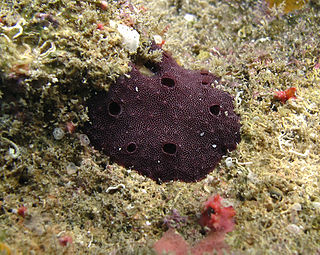
Dacrydium is a genus of conifers belonging to the podocarp family Podocarpaceae. Sixteen species of evergreen dioecious trees and shrubs are presently recognized. The genus was first described by Solander in 1786, and formerly included many more species, which were divided into sections A, B, and C by Florin in 1931. The revisions of de Laubenfels and Quinn, reclassified the former section A as the new genus Falcatifolium, divided Section C into new genera Lepidothamnus, Lagarostrobos and Halocarpus, and retained Section B as genus Dacrydium.
Falcatifolium is a genus of conifers of the family Podocarpaceae. The genus includes evergreen dioecious shrubs and large trees of up to 36 metres (118 ft). Five species are presently recognized. The genus was first described by de Laubenfels in 1969, and is composed of species formerly classified in genus Dacrydium.

Leucettidae is a family of sea sponges in the subclass Calcinea, first described by Max Walker de Laubenfels in 1936.

Halichondriidae is a family of sea sponges belonging to the order Suberitida. These sponges have a skeleton consisting of dense bundles of spicules occurring in a more or less random pattern.

Spongia is a genus of marine sponges in the family Spongiidae, originally described by Carl Linnaeus in 1759, containing more than 60 species. Some species, including Spongia officinalis, are used as cleaning tools, but have mostly been replaced in that use by synthetic or plant material.

Axinella is a genus of sponges in the family Axinellidae first described in 1862 by Eduard Oscar Schmidt. Species of Axinella occur in the Indian and Pacific Oceans. Most of these sponges are smaller than 20 cm, and have a yellow or orange colour.
Hymeniacidon is a genus of sea sponges in the class Demospongiae. Some members of the genus are known to be mobile, achieving speeds of between 1 and 4 mm per day.

Cliona is a genus of demosponges in the family Clionaidae. It contains about eighty described species.

Clathria is a large genus of demosponges in the family Microcionidae.

Microcionidae is a family of marine demosponges.

Haliclona is a genus of demosponges in the family Chalinidae.

Darwinellidae is a family of sponges in the order Dendroceratida.

Haplosclerida is an order of demosponges. It contains the following families:

Xestospongia is a genus of sponges in the family Petrosiidae. It contains the following species:
Neopetrosia is a genus of marine petrosiid sponges. It was first established by the American spongiologist Max Walker de Laubenfels in 1932. It contains these 27 species:
Max Walker de Laubenfels (1894–1960) was an American spongiologist. He received his undergraduate degree from Oberlin College and his doctorate from Stanford University.
David John de Laubenfels or D. J. de Laubenfels was an American botanist known as an expert on tropical conifers.
Protomonaxonida is an extinct order of sea sponges. It is a paraphyletic group gathering the most ancient species from the Burgess Shale to modern sponges.
Calyx is a genus of sea sponges of the family Phloeodictyidae.











